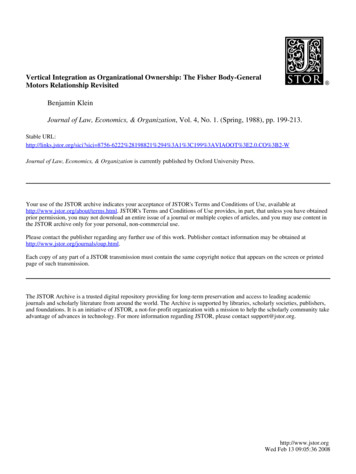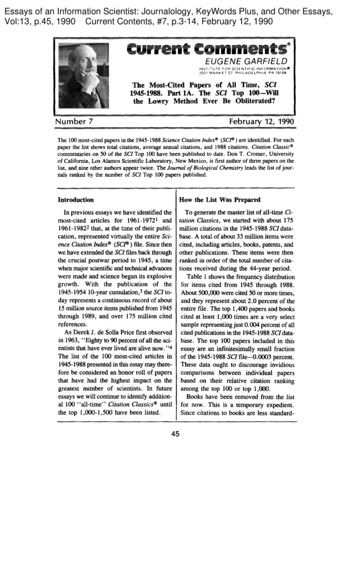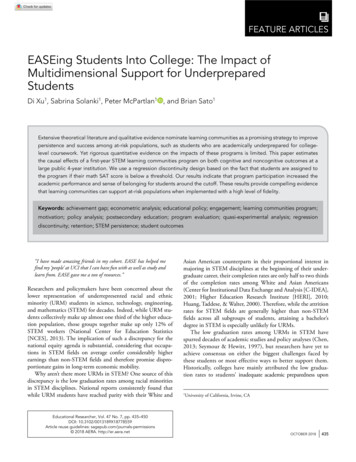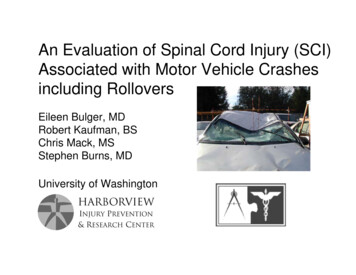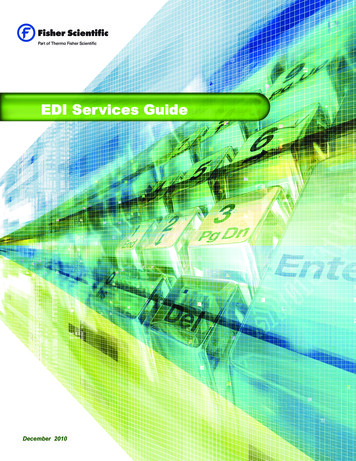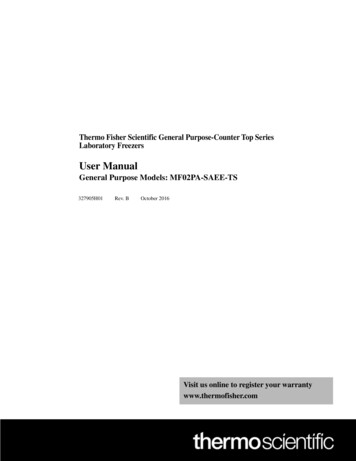
Transcription
User GuideNitrateIon SelectiveElectrode
ROSS and the COIL trade dress are trademarks of Thermo Fisher Scientific Inc.AQUAfast, Cahn, ionplus, KNIpHE, No Cal, ORION, perpHect, PerpHecT, PerpHecTion,pHISA, pHuture, Pure Water, Sage, Sensing the Future, SensorLink, ROSS, ROSSUltra, Sure-Flow, Titrator PLUS and TURBO2 are registered trademarks ofThermo Fisher.1-888-pHAX-ION, A , All in One, Aplus, AQUAsnap, AssuredAccuracy, AUTO-BAR,AUTO-CAL, AUTO DISPENSER, Auto-ID, AUTO-LOG, AUTO-READ, AUTO-STIR, Auto-Test,BOD AutoEZ, Cable-Free, CERTI-CAL, CISA, DataCOLLECT, DataPLUS, digital LogR,DirectCal, DuraProbe, Environmental Product Authority, Extra Easy/Extra Value,FAST QC, GAP, GLPcal, GLPcheck, GLPdoc, ISEasy, KAP, LabConnect, LogR, LowMaintenance Triode, Minimum Stir Requirement, MSR, NISS, One-Touch, One-TouchCalibration, One-Touch Measurement, Optimum Results, Orion Star, Pentrode,pHuture MMS, pHuture Pentrode, pHuture Quatrode, pHuture Triode, Quatrode,QuiKcheK, rf link, ROSS Resolution, SAOB, SMART AVERAGING, Smart CheK, SMARTSTABILITY, Stacked, Star Navigator 21, Stat Face, The Enhanced Lab, ThermaSense,Triode, TRIUMpH, Unbreakable pH, Universal Access are trademarks ofThermo Fisher. 2008 Thermo Fisher Scientific Inc. All rights reserved. All trademarks are theproperty of Thermo Fisher Scientific Inc. and its subsidiaries.The specifications, descriptions, drawings, ordering information and part numberswithin this document are subject to change without notice.This publication supersedes all previous publications on this subject.
Table of ContentsIntroduction . . . . . . . . . . . . . . . . . . . . . . . . . . . . . . . . . . . . . . 1Required Equipment . . . . . . . . . . . . . . . . . . . . . . . . . . . . . . . 2Serial Dilutions . . . . . . . . . . . . . . . . . . . . . . . . . . . . . . . . . . . 4Electrode Setup . . . . . . . . . . . . . . . . . . . . . . . . . . . . . . . . . . 59307BNWP Nitrate Half-Cell Electrode Preparation . . . . . . . . . . 5900200 Double Junction Reference Electrode Preparation . . . . . 59707BNWP Nitrate Combination Electrode Preparation . . . . . . 6Checking Electrode Operation (Slope) . . . . . . . . . . . . . . . . . . . . . 8Measurement Units . . . . . . . . . . . . . . . . . . . . . . . . . . . . . . . . . . . 9Sample Requirements . . . . . . . . . . . . . . . . . . . . . . . . . . . . . . . . . 9Measuring Hints . . . . . . . . . . . . . . . . . . . . . . . . . . . . . . . . . . . . 10Electrode Storage . . . . . . . . . . . . . . . . . . . . . . . . . . . . . . . . . . . 11Electrode Maintenance . . . . . . . . . . . . . . . . . . . . . . . . . . . . . . . 12Analytical Techniques . . . . . . . . . . . . . . . . . . . . . . . . . . . . 14Direct Calibration Technique . . . . . . . . . . . . . . . . . . . . . . . . . . . .Small Volume Direct Calibration Technique . . . . . . . . . . . . . . . .Low Level Calibration Technique . . . . . . . . . . . . . . . . . . . . . . . .Known Addition Technique . . . . . . . . . . . . . . . . . . . . . . . . . . . . .16202426Electrode Characteristics . . . . . . . . . . . . . . . . . . . . . . . . . 34Electrode Response . . . . . . . . . . . . . . . . . . . . . . . . . . . . . . . . . 34Reproducibility . . . . . . . . . . . . . . . . . . . . . . . . . . . . . . . . . . . . . . 34Limits of Detection . . . . . . . . . . . . . . . . . . . . . . . . . . . . . . . . . . 35Electrode Life . . . . . . . . . . . . . . . . . . . . . . . . . . . . . . . . . . . . . . .35Temperature Effects . . . . . . . . . . . . . . . . . . . . . . . . . . . . . . . . . 36Interferences . . . . . . . . . . . . . . . . . . . . . . . . . . . . . . . . . . . . . . . 37Theory of Operation . . . . . . . . . . . . . . . . . . . . . . . . . . . . . . . . . 40Troubleshooting . . . . . . . . . . . . . . . . . . . . . . . . . . . . . . . . . 42Assistance . . . . . . . . . . . . . . . . . . . . . . . . . . . . . . . . . . . . . . . . . 43Warranty . . . . . . . . . . . . . . . . . . . . . . . . . . . . . . . . . . . . . . . . . . 43Troubleshooting Checklist . . . . . . . . . . . . . . . . . . . . . . . . . . . . . 44Ordering Information . . . . . . . . . . . . . . . . . . . . . . . . . . . . . 45Specifications . . . . . . . . . . . . . . . . . . . . . . . . . . . . . . . . . . . 46Nitrate Ion Selective Electrode User Guide
IINitrate Ion Selective Electrode User Guide
IntroductionThis user guide contains information on the preparation,operation and maintenance for the nitrate ion selective electrode(ISE). General analytical procedures, electrode characteristicsand electrode theory are also included in this user guide. Nitrateelectrodes measure free nitrate ions in aqueous solutions quickly,simply, accurately and economically.Technical Support Chemists can be consulted for assistanceand troubleshooting advice. Within the United States call1.800.225.1480 and outside the United States call 978.232.6000or fax 978.232.6031. In Europe, the Middle East and Africa,contact your local authorized dealer. For the most currentcontact information, visit www.thermo.com/contactwater.For the latest application and technical resources for ThermoScientific Orion products, visit www.thermo.com/waterapps.Nitrate ionplus Sure-Flow Plastic MembraneCombination ISE, Cat. No. 9707BNWPThe nitrate combination electrode has the sensing and referencehalf-cells built into one electrode, which decreases the amountof required solutions and reduces waste. The built-in Sure-Flowreference junction prevents electrode clogging and providesfast and stabile readings. The nitrate combination electrode isavailable with a waterproof BNC connector, Cat. No. 9707BNWP.Electrodes with a waterproof BNC connector can be used on anyISE or mV meter with a BNC connection.Nitrate Plastic Membrane Half-Cell ISE,Cat. No. 9307BNWPThe nitrate half-cell electrode must be used with thedouble junction reference electrode, Cat. No. 900200. Thenitrate half-cell electrode is available with a waterproof BNCconnector, Cat. No. 9307BNWP. Electrodes with a waterproofBNC connector can be used on any ISE or mV meter with aBNC connection.Nitrate Ion Selective Electrode User Guide
Required Equipment1.Thermo Scientific Orion ISE meter, such as the 4-Star pH/ISEmeter or 5-Star pH/ISE/DO/conductivity meter; equivalentISE meter; or mV meter with a 0.1 mV resolution.Nitrate electrodes can be used on any ISE or mV meterwith a BNC connection. The electrodes can also be usedon meters with a variety of inputs when an adapter cable isused. Visit www.thermo.com/water for details.2. Thermo Scientific Orion nitrate electrode.The 9307BNWP nitrate half-cell electrode requires aseparate reference electrode, Cat. No. 900200.3. Magnetic stirrer or Thermo Scientific Orion stirrer probe,Cat. No. 096019. The stirrer probe can be used with 3-Star,4-Star and 5-Star benchtop meters.4. Volumetric flasks, graduated cylinders and beakers. Plasticlabware is required for low level nitrate analysis.5. Distilled or deionized water.6. Nitrate electrode filling solution.Use Optimum Results F filling solution, Cat. No. 900046,for the 9707BNWP nitrate combination electrode.Use inner chamber filling solution, Cat. No. 900002, andnitrate ISA, Cat. No. 930711, or Optimum Results F fillingsolution, Cat. No. 900046, for the double junction referenceelectrode that is used with the 9307BNWP nitrate half-cellelectrode. Either the nitrate ISA or Optimum Results F fillingsolution can be used as the outer chamber filling solution.7. Nitrate calibration standards.Cat. No.Description9207060.1 M NaNO3 nitrate calibration standard9207071000 ppm as N nitrate calibration standard930707100 ppm as N nitrate calibration standardNitrate Ion Selective Electrode User Guide
8. Nitrate ionic strength adjuster (ISA), Cat. No. 930711.ISA provides a constant background ionic strength forsamples and standards.Nitrate interference suppressor solution (NISS), Cat. No.930710, can be used in place of the nitrate ISA to remove avariety of interfering anions, including chloride ions, presentin samples such as drinking water, wastewater and soils.Refer to the Interferences section for details.9. Preservative solution – add 1 mL of preservative solution toevery 100 mL of standards and samples to prevent biologicaldegradation of the solutions.Prepare a 1 M boric acid preservative solution by dissolving6.2 grams of reagent-grade boric acid in 100 mL of boilingwater. Let the solution cool.Nitrate Ion Selective Electrode User Guide
Serial DilutionsSerial dilution is the best method for the preparation ofstandards. Serial dilution means that an initial standard is diluted,using volumetric glassware, to prepare a second standardsolution. The second standard is similarly diluted to prepare athird standard, and so on, until the desired range of standardshas been prepared.1.To prepare a 10-2 M standard (140 ppm as N) –Pipet 10 mL of the 0.1 M standard into a 100 mL volumetricflask. Dilute to the mark with deionized water and mix well.2.To prepare a 10-3 M standard (14.0 ppm as N) –Pipet 10 mL of the 10-2 M standard into a 100 mL volumetricflask. Dilute to the mark with deionized water and mix well.3.To prepare a 10-4 M standard (1.40 ppm as N) –Pipet 10 mL of the 10-3 M standard into a 100 mL volumetricflask. Dilute to the mark with deionized water and mix well.To prepare standards with a different concentration use thefollowing formula:C1 * V1 C2 * V2C1 concentration of original standardV1 volume of original standardC2 concentration of standard after dilutionV2 volume of standard after dilutionFor example, to prepare 100 mL of a 100 ppm nitrate standardfrom a 1400 ppm nitrate standard:C1 1400 ppm nitrateV1 unknownC2 100 ppm nitrateV2 100 mL1400 ppm * V1 100 ppm * 100 mLV1 (100 ppm * 100 mL) / 1400 ppm 7.14 mL Nitrate Ion Selective Electrode User Guide
Electrode Setup9307BNWP Nitrate Half-CellElectrode PreparationRemove the sensing module from the vial and save the vial forelectrode storage. Make sure that the rubber electrode washeron the sensing module is in place. See Figure 1. Screw thesensing module into the electrode body until the module isfinger-tight. To ensure electrical continuity, shake the electrodedown like a clinical thermometer. Rinse the nitrate electrodewith distilled water and then soak it in a 100 ppm or 10-2 Mnitrate standard for 1 to 2 hours prior to use.Note: Do not immerse the electrode past the rubberelectrode washer.900200 Double Junction ReferenceElectrode PreparationPrepare the reference electrode according to the referenceelectrode user guide. Fill the reference electrode with innerchamber filling solution, Cat. No. 900002, and either nitrate ISA,Cat. No. 930711, or Optimum Results F filling solution, Cat. No.900046 as the outer chamber filling solution.Note: Do not use the outer chamber filling solution that shipswith the 900200 double junction reference electrode because itcontains interferences for nitrate measurements.Figure 19307BNWP Nitrate Half-Cell ElectrodeElectrode BodyWasherSensing ModuleSensing MembraneNitrate Ion Selective Electrode User Guide
9707BNWP Nitrate CombinationElectrode PreparationNote: Do not to touch the sensing membrane or reference pelletduring the electrode assembly.1.Remove the sensing module from the vial and save the vialfor storage. Make sure that both O-rings are in place on themodule. Remove the electrode handle from the box.2. Unscrew the electrode cap. Slide the cap and spring downthe electrode cable.3. Hold the outer body sleeve and gently push the inner stemthrough the outer body. Slide the outer body sleeve downthe electrode cable until it is beyond the inner stem.4. Grasp the middle of the inner stem without touching thereference pellet. If a red storage tip is connected to theinner stem, unscrew it and save it for storage.5. Screw the sensing module into the stem until it stops andthe module is flush against the stem. Tighten the modulean additional one-quarter turn. The module should be firmlyattached to the stem. Do not overtighten the module.6. Hold the electrode cable and slide the outer body, spring andcap over the inner stem.7.Grasp the outer body sleeve, without touching the sensingmembrane, and gently screw the cap onto the inner stemwhile pulling on the cable. Stop when an opposite force isfelt. Do not overtighten or continue to turn the cap. The capwill not completely stop. If the inner body turns at all, thecap is too tight. Remove the cap and reassemble.8. Press on the top of the cap with your thumb to make surethat the electrode has a smooth flushing motion and theouter body sleeve returns to its original position.9. Install the flip spout cap onto the Optimum Results F fillingsolution bottle and lift the flip spout to a vertical position.Insert the spout into the electrode fill hole and add a smallamount of filling solution to the reference chamber.10. Hold the electrode body and use your thumb to push downon the electrode cap to allow a few drops of filling solutionto drain out of the electrode. Release the electrode cap.11. If the sleeve does not return to its original position, addfilling solution and repeat step 10 until the sleeve returns toits original position. Nitrate Ion Selective Electrode User Guide
12. Add filling solution to the electrode up to the fill hole.13. Rinse the electrode with distilled water and soak it in a100 ppm or 10-2 M nitrate standard for 1 to 2 hours priorto use.Note: Add filling solution each day before using the electrode.The filling solution level should be at least one inch above thelevel of sample in the beaker to ensure a proper flow rate. The fillhole should always be open when taking measurements.Figure 29707BNWP Nitrate Combination Electrodecapspringfill holeouter body sleeveinner stemreference pelletO-ringssensing modulesensing membraneNitrate Ion Selective Electrode User Guide
Checking Electrode Operation (Slope)These are general instructions that can be used with mostmeters to check the electrode operation. Refer to the meter userguide for more specific information.This procedure measures electrode slope. Slope is definedas the change in millivolts observed with every tenfold changein concentration. Obtaining the slope value provides the bestmeans for checking electrode operation.1.If the electrode has been stored dry, prepare the electrodeas described in the Electrode Preparation section.2. Connect the electrode to a meter with a mV mode. Set themeter to the mV mode.3. Add 100 mL of distilled water and 2 mL of ISA, Cat. No.930711, into a 150 mL beaker. Stir the solution thoroughly.4. Rinse the electrode with distilled water and place theelectrode into the solution prepared in step 3.5. Select either a 0.1 M or 1000 ppm nitrate standard. Pipet1 mL of the standard into the beaker and stir the solutionthoroughly. When a stable reading is displayed, record theelectrode potential in millivolts.6. Pipet 10 mL of the same standard into the same beakerand stir the solution thoroughly. When a stable reading isdisplayed, record the electrode potential in millivolts.7.There should be a -54 to -60 mV difference between the twomillivolt readings when the solution temperature is between20 to 25 C. If the millivolt potential is not within this range,refer to the Troubleshooting section. Nitrate Ion Selective Electrode User Guide
Measurement UnitsNitrate concentration can be measured in moles per liter (M),parts per million (ppm) or any convenient concentration unit.Table 1Concentration Unit Conversion FactorsMoles/Liter (M)ppm as NO3-ppm as -46.201.40Sample RequirementsAll samples must be aqueous and must not contain organicsolvents. Contact Technical Support for information on using theelectrode for specific applications.The solution temperature must be less than 40 C.Samples and standards should be at the same temperature. A1 C difference in temperature for a 10-3 M nitrate solution willgive rise to about a 1.5% error.Interferences should be absent from all samples. See theInterferences section for a list of possible interferences. Ifinterferences are present in the sample and cannot be removed,use the nitrate interference suppressor solution (NISS), Cat. No.930710, in a 1:1 ratio of solution to NISS. Do not use ISA whenusing the nitrate interference suppressor solution.In all analytical procedures, ISA or NISS must be added to allsamples and standards before measurements are taken.Nitrate Ion Selective Electrode User Guide
Measuring Hints Stir all standards and samples at a uniform, moderate rate.Place a piece of insulating material, such as Styrofoam orcardboard, between the magnetic stir plate and beaker toprevent measurement errors from the transfer of heat tothe sample. Always use freshly prepared standards for calibration. Always rinse the electrode with distilled water betweenmeasurements and shake the electrode to remove thewater and prevent sample carryover. Do not wipe or rub theelectrode sensing module. Store the nitrate electrode in a 10-2 M or 100 ppm nitratestandard between measurements. The 9307BNWP nitrate half-cell electrode should beimmersed in standards and samples to approximatelyhalf the length of the nitrate module. Do not immersethe nitrate electrode past the electrode washer. Immersethe reference electrode to the same depth as the nitrateelectrode. Allow all standards and samples to reach the sametemperature for precise measurements. Verify the electrode calibration every two hours by placingthe electrode in a fresh aliquot of the least concentratedstandard used for calibration. If the value has changed bymore than 2%, recalibrate the electrode. After immersing the electrode in a solution, check theelectrode sensing surface for air bubbles and remove airbubbles by reimmersing the electrode in the solution andgently tapping it. For high ionic strength samples, prepare standards with abackground composition similar to the sample. The fill hole cover must be open during measurements toensure a uniform flow of filling solution. If the combination electrode is used and the electrode isused in dirty or viscous samples or the electrode responsebecomes sluggish, empty the electrode completely, holdthe junction open and flush the junction with distilled water.Empty any water from the electrode and refill it with freshfilling solution. Press down on the electrode cap to let a fewdrops of the filling solution flow out of the electrode andthen replenish any lost solution.10Nitrate Ion Selective Electrode User Guide
Electrode StorageNitrate Combination Electrode Storage,Cat. No. 9707BNWPFor storage between measurements and up to three days, storethe electrode in a 10-2 M or 100 ppm nitrate standard. The fillingsolution inside the electrode should not be allowed to evaporate,as crystallization will result.For storage longer than one week, drain the electrode, flushthe reference chamber with distilled water, disassemble theelectrode and store the sensing module in the glass vial.1.Grasp the outer body sleeve and unscrew the electrode cap.Slide the cap and spring assembly down the electrode cable.2. Push the inner stem of the electrode handle out through theouter electrode sleeve, exposing the sensing module.3. Rinse the inner stem and module well with distilled water.Gently blot dry to prevent damaging the sensing module.4. Carefully unscrew the sensing module from the inner stem,taking care not to touch the sensing membrane.5. Place the nitrate sensing module in the glass vial until it isneeded again. Gently blot dry the inside of the inner stemand O-ring area, reassemble the electrode handle withoutthe module and store it dry.Nitrate Half-Cell Electrode Storage,Cat. No. 9307BNWPThe nitrate half-cell electrode should be rinsed thoroughly withdistilled water and stored a 10-2 M or 100 ppm nitrate standard.When storing the electrode for more than three days, rinse thenitrate half-cell electrode thoroughly with distilled water, shakethe electrode dry, disassemble the electrode and store thesensing module in the glass vial.Double Junction Reference Electrode Storage,Cat. No. 900200The double junction reference electrode may be stored inthe nitrate ISA or Optimum Results F filling solution betweensample measurements and up to one week. The filling solutioninside the electrode should not be allowed to evaporate, ascrystallization will result.For storage longer than one week, drain the reference electrode,flush the inside with distilled water and store the electrode dry.Nitrate Ion Selective Electrode User Guide11
Electrode MaintenanceCleaning the Nitrate Sensing ModuleIf the electrode is exposed to high levels of interfering ions, itmay drift and become sluggish in response. When this happens,restore normal performance by soaking the electrode for anhour in distilled water, emptying the old filling solution, fillingthe electrode with fresh filling solution and then soaking theelectrode for a few hours a 10-2 M or 100 ppm nitrate standard.If soaking the electrode does not restore normal electrodeperformance, replace the nitrate sensing module.Nitrate Combination Electrode and Double JunctionReference Electrode FlushingIf the area between the electrode outer body and inner conebecomes clogged with sample or precipitate, flush the area withfilling solution or distilled water.1.Hold the electrode body with one hand and use your thumbto push down on the electrode cap to drain all of the fillingsolution out of the electrode.2. Fill the electrode with distilled water and then push downon the cap until all the water is drained from the chamber.Repeat this procedure until all of the sample or precipitate isremoved from the electrode.3. Fill the electrode with fresh filling solution up to the fill hole.Push down on the cap to allow a few drops of filling solutionto drain out of the electrode and then replenish the lostfilling solution.4. Rinse the electrode with distilled water and soak it in a10-2 M or 100 ppm nitrate standard for 1 to 2 hours.12Nitrate Ion Selective Electrode User Guide
Replacing the Nitrate Sensing ModuleThe sensing membrane of plastic membrane electrodes willwear over time, indicated by low slope values, drift, poorreproducibility and loss of response in low level samples. Theelectrode response can be restored by replacing the sensingmodule. Each sensing module will last about three months withnormal laboratory use, but the actual lifespan of the sensingmodule will depend on the type of samples that are measured.For the 9707BNWP nitrate combination electrode, use the 97series nitrate module, Cat. No. 970701.Drain the electrode and flush the reference chamber withdistilled water. Hold the outer body sleeve and unscrew theelectrode cap. Slide the cap and spring assembly down theelectrode cable. Push the inner stem of the electrode handleout through the outer electrode sleeve, exposing the sensingmodule. Rinse the inner stem and module well with distilledwater. Gently blot dry to prevent damaging the sensing module.Carefully unscrew the sensing module from the inner stem anddispose of the old sensing module. Obtain a new 97 seriesnitrate module, Cat. No. 970701, and refer to the 9707BNWPNitrate Combination Electrode Preparation section fordetailed instructions on assembling the electrode.For the 9307BNWP nitrate half-cell electrode, use the93 series nitrate module, Cat. No. 930702.Rinse the electrode with distilled water. Carefully unscrewthe sensing module from the electrode and dispose of the oldsensing module. Obtain a new 93 series nitrate module, Cat.No. 930702, and refer to the 9307BNWP Nitrate Half-CellElectrode Preparation section for detailed instructions onassembling the electrode.Nitrate Ion Selective Electrode User Guide13
Analytical TechniquesA variety of analytical techniques are available to the analyst. Thefollowing is a description of these techniques.Direct Calibration is a simple procedure for measuring a largenumber of samples. Only one meter reading is required for eachsample. Calibration is performed using a series of standards.The concentration of the samples is determined by comparisonto the standards. ISA is added to all solutions to ensure thatsamples and standards have similar ionic strength.Low Level Calibration is a similar to the direct calibrationtechnique. This method is recommended when the expectedsample concentration is less than 10-4 M or 1.4 ppm nitrate asnitrogen (N). A minimum three point calibration is recommendedto compensate for the electrode’s non-linear response at theseconcentrations. A special calibration standard preparationprocedure is the best means of preparing low level calibrationstandards.Incremental Techniques provide a useful method for measuringsamples, since a calibration is not required. The differentincremental techniques are described below. They can beused to measure the total concentration of a specific ion in thepresence of a large (50 to 100 times) excess of complexingagents. As in direct calibration, any convenient concentrationunit can be used. Known Addition is useful for measuring dilute samples,checking the results of direct calibration (when nocomplexing agents are present), or measuring the totalconcentration of an ion in the presence of an excesscomplexing agent. The electrode is immersed in the samplesolution and an aliquot of a standard solution containing themeasured species is added to the sample. From the changein potential before and after the addition, the original sampleconcentration is determined.14Nitrate Ion Selective Electrode User Guide
Table 2Recommended Measuring TechniquesDirectSmallVolumeDirectLow Level[N] 1.4 ppm[N] 1.4 ppm OccasionalSampling Small samplevolumeLarge numberof samples Reducechemicalusage Fieldmeasurement Ionicstrengthgreater than0.1 MKnownAddition Nitrate Ion Selective Electrode User Guide 15
Direct Calibration TechniqueTypical Direct Calibration CurveIn the direct calibration procedure, a calibration curve isconstructed either in the meter memory or on semi-logarithmicpaper. Electrode potentials of standard solutions are measuredand plotted on the linear axis against their concentrations on thelog axis. In the linear regions of the curves, only two standardsare needed to determine a calibration curve. In non-linearregions, more points must be taken. These direct calibrationprocedures are given for concentrations in the region of linearelectrode response. Low level measurement procedures aregiven in a following section for measurements in the non-linearelectrode region.Figure 3Typical Direct Calibration Curve- 85- 65electrodepotential(relative mV)- 45- 25-5 15 3510-fold change56mV 55 75 95 115 135.1.1111010100 1000100 100010-6 10-5 10-4 10-3 10-2 10-116ppm Nitrateas Nppm Nitrateas NO3molarityNitrate Ion Selective Electrode User Guide
Direct Calibration OverviewThe following direct measurement procedures are recommendedfor moderate to high level measurements. Samples mustbe in the linear range of the electrode – greater than 10-4 Mor 1.4 ppm nitrate as N. A two point calibration is sufficient,although more points can be used. When using an ISE meter,sample concentrations can be read directly from the meter.When using a mV meter, a calibration curve can be preparedon semi-logarithmic graph paper, or a linear regression (againstlogarithmic concentration values) can be performed using aspreadsheet or graphing program.Calibration Hints Standard concentrations should bracket the expectedsample concentrations. Always add 2 mL of ISA, Cat. No. 930711, per 100 mL ofstandard or sample. If interferences are present in thesample and cannot be removed, add 50 mL of NISS, Cat.No. 930710, per 50 mL of standard or sample. Do not useISA when using the nitrate interference suppressor solution. For high ionic strength samples that have an ionic strengthof 0.1 M or greater, prepare standards with a backgroundcomposition similar to that of the samples, or measure thesamples using the known addition method. During calibration, measure the least concentrated standardfirst, and work up to the most concentrated standard.Direct Calibration Setup1.Prepare the electrode as described in the ElectrodePreparation section. If using the 9707BNWP combinationnitrate electrode, fill the electrode with Cat. No. 900046. Ifusing the 9307BNWP half-cell nitrate electrode with the900200 reference electrode, fill the reference electrode withinner chamber filling solution, Cat. No. 900002, and nitrateISA, Cat. No. 930711, or Optimum Results F filling solution,Cat. No. 900046 as the outer chamber filling solution.2. Connect the electrode to the meter.3. Prepare at least two standards that bracket the expectedsample range and differ in concentration by a factor of ten.Standards can be prepared in any concentration unit to suitthe analysis requirement. See the Serial Dilution sectionfor instructions preparing standards. All standards should beat the same
2 . -3 To prepare a 10 M standard (14.0 ppm as N) - Pipet 10 mL of the 10-2 M standard into a 100 mL volumetric flask . Dilute to the mark with deionized water and mix well . 3 . To prepare a 10-4 M standard (1.40 ppm as N) - Pipet 10 mL of the 10-3 M standard into a 100 mL volumetric flask . Dilute to the mark with deionized water and mix .


